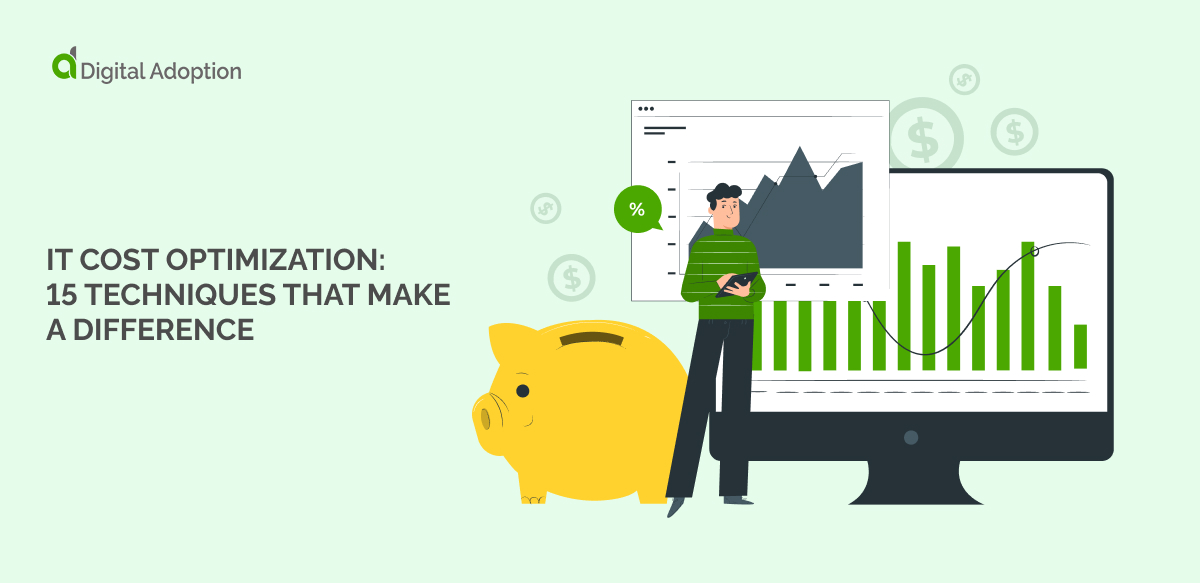IT cost optimization is a business practice that makes IT assets as cost-effective as possible.
IT cost optimization initiatives look at business activities like the cost of hardware, software subscriptions, training, and overall digital adoption.
This process finds ways to make more IT investments. In many cases, they find a way to improve the ROI on tech assets.
The suggested outcomes of IT cost optimization can vary: vendor changes, further digital adoption projects, or enhanced employee training.
You need financial expertise, technical knowledge, and user empathy to navigate this process successfully.
This article will support anyone seeking to optimize IT costs in their organization and aims to:
- Explain the meaning of IT cost optimization
- Introduce some of the core principles of IT cost optimization
- Show you a list of 15 top IT cost optimization techniques
- Explore some of the most specialist areas of IT cost optimization
By the end of the article, you’ll see how cost optimization feeds into maximizing business results.
What is Cost Optimization in IT?
IT costs can be a huge part of operating expenses. In 2024, estimates from Gartner suggest that global expenditure on IT will accelerate by as much as 8.8%.
Although technology is essential for modern businesses, it’s too easy for the costs to get out of control.
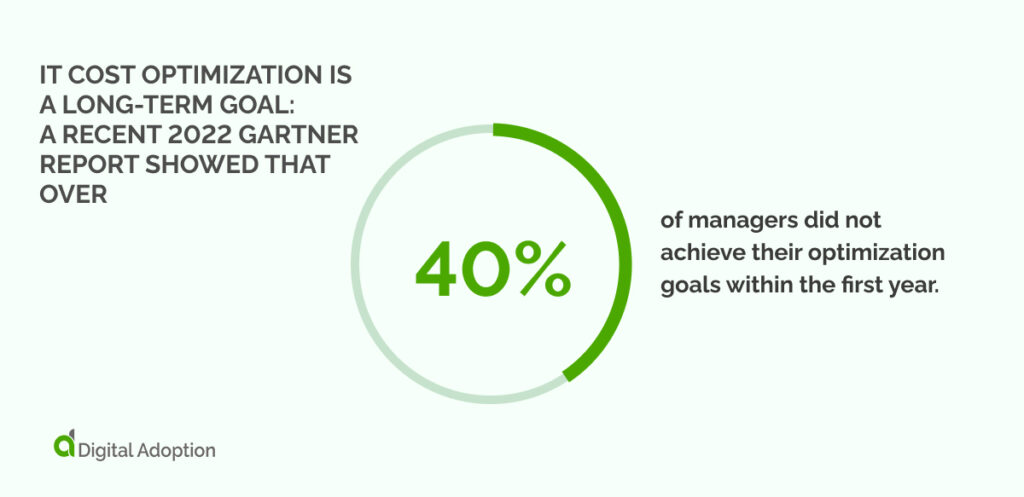
In this context, IT cost optimization steps in to maximize the business value of investments. Strategically optimizing IT costs helps to realize long-term business goals. IT cost optimization is a long-term goal: a recent 2022 Gartner report showed that over 40% of managers did not achieve their optimization goals within the first year.
IT cost optimization may pay attention to the following areas:
- Attention to the procurement of IT services
- Analysis of pricing models and subscriptions
- Careful monitoring of all IT costs
- Standardization of software provision arrangements
- Removal of redundant technology
- Evaluating tech ROI
- Automating processes
- Finding ways to introduce new IT innovations and strategies
The optimization process begins at the implementation stage. It then continues for the duration of a company. Unlike cost-cutting, optimizing costs is a never-ending process. Your company must keep up with the latest trends as business practices change.
The good news is that cost optimization creates value for a company’s overall operations. After all, the IT services the business provides can be improved. And with those improvements, business costs can be far cheaper.
IT Cost Optimization Principles
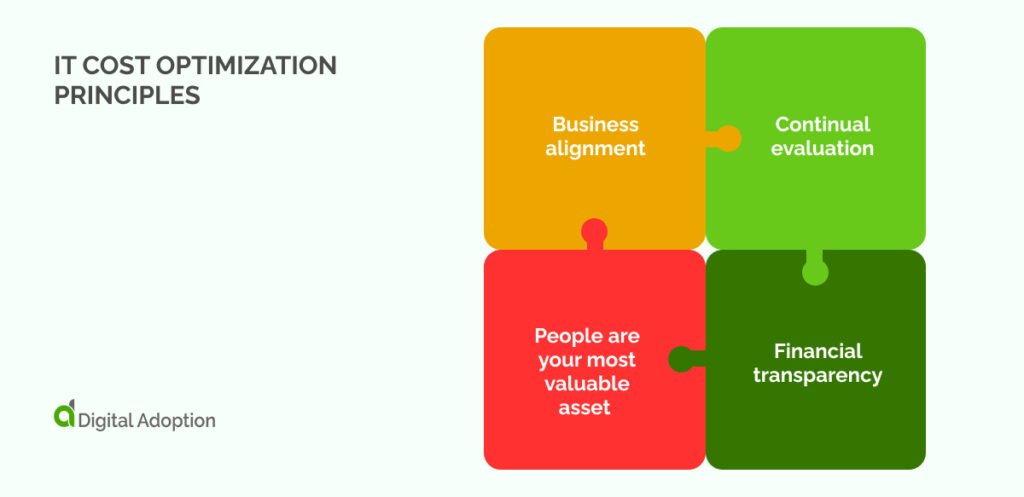
Although cost optimization is difficult, it’s based on some core fundamental business principles. Ensure you have the basic principles before you think about the right techniques. These include:
Business alignment
Business goal alignment ensures that cost optimization efforts directly contribute to the organization’s objectives.
By aligning IT cost optimization with business goals, companies can prioritize investments that maximize value, drive efficiency, and support growth. This approach prevents cost reduction from compromising essential functions or stifling innovation. As a result, it supports long-term business success.
Moreover, it helps maintain a clear focus on delivering value to customers, shareholders, and other stakeholders while managing IT costs effectively.
Continual evaluation
Continual monitoring is a vital component of strategic IT cost optimization. Cost optimization is not a one-off event. So, organizations need lots of data to adapt and refine their cost-saving strategies over time.
Whether using a Digital Adoption Platform (DAP), ongoing analysis, or adapting to evolving approaches, this persistent vigilance ensures that cost-saving initiatives remain effective and aligned with current business needs.
While it may require hard work, having the right tools, such as dashboards and data analytics, simplifies the process and empowers businesses to make informed decisions, optimize IT costs, and maintain their competitive edge in a dynamic business landscape.
Financial transparency
IT cost optimization and financial transparency make great friends.
IT managers may feel defensive when their services could be reduced. But, they can use great optimization strategies to illustrate and explain their needs.
Creating complete transparency is enough to prove the business value of the money spent everywhere. If C-suite staff understand the importance that’s coming out of their IT vendor investments, the chances of maintaining a reasonable budget improve.
People are your most valuable asset
As digital transformation professionals know, technology is only one side of a business solution. New IT processes don’t make sense without the right staff implementing and using them.
IT cost optimization is a long-term strategy, not a one-off event. Like any long-term strategy, it’s essential that staff can change with the new demands of the company.
Good recruitment, training, and deployment practices will ensure that the new technologies in a business have the experts to go with them.
Remember, though, that optimizing costs through people is not about redundancies. After all, as a BCG analysis from 2020 explains clearly, “reducing staff across the board today could hurt your ability to deliver services tomorrow.”
15 IT Cost Optimization Techniques
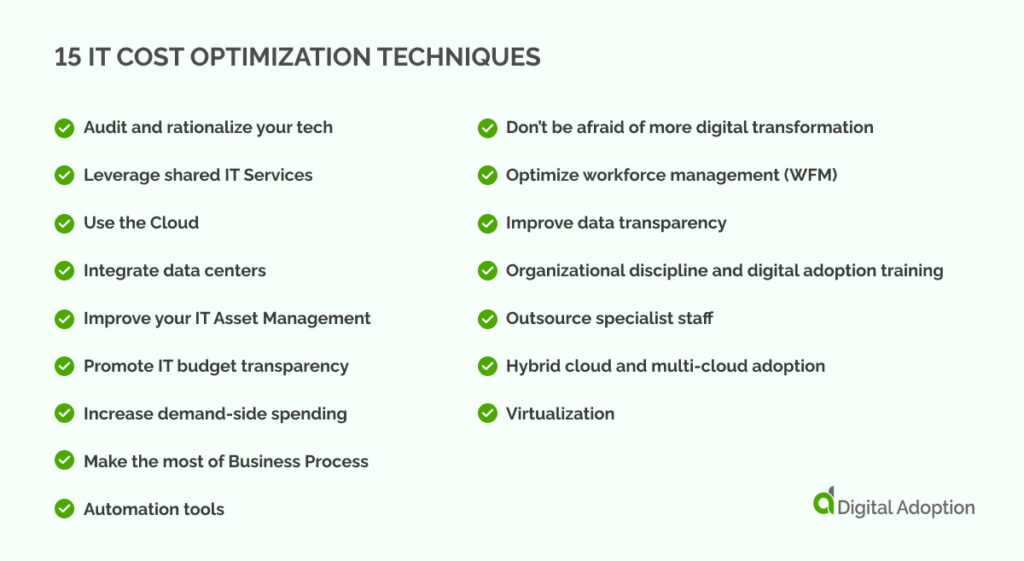
Let’s admit it. The right IT cost optimization techniques for you will depend on many factors. The size of your business, the nature of your operations, and the specific IT functions you use will all make a difference.
That’s why we’re providing a comprehensive list of cost optimization techniques here. They won’t be right for every situation. But have a read, and you’ll surely find something that works for your business.
- Audit and rationalize your tech
A good initiative can start with a transparent audit of all the technology that the company currently uses. It can be as simple as a spreadsheet listing all the applications used within the organization, detailing the features, costs, and intended users.
An essential application for one business unit may be completely unheard of elsewhere.
As such, keeping a clear eye on all the subscription-based applications within an origination can be difficult. Rationalization means that you know what’s going on and where.
- Leverage shared IT Services
If an organization has an aerial view of its IT resources, it can choose to share cross-functionality of subscriptions between departments and teams.
When services are used across different business units, a business can ensure they are pursuing a shared procurement and subscription package.
This approach allows organizations to leverage economies of scale and reduce duplication of resources and can lead to surprising cost savings through more competitive pricing models.
- Use the Cloud
Cloud-based software is itself a great cost optimization technology.
Believe it or not, some companies are still not utilizing the cloud for their IT infrastructure.
Cloud resources are now one of the dominant ways of bringing technology into a company. Many applications will struggle to work on a genuine site-based option.
Cloud-based software can often be more flexible than existing systems, making it easier to adapt the service over time. With that functionality, cloud transformation can more rapidly lead to business innovation.
- Integrate data centers
A data center is one of the most vital parts of IT infrastructure, even though many users will never think about it.
A report from McKinsey suggests that better data management can reduce costs without negatively impacting business processes: “for example, by offloading historical data to lower-cost storage, increasing server utilization, or halting renewals of server contracts.”
As data needs grow with a company, so will its storage needs. Bringing every storage provision into one data center will inevitably reduce costs and maintain the simplicity of operations.
- Improve your IT Asset Management
IT asset management monitors all aspects of IT infrastructure. It provides a detailed understanding of the specific items held by a company. That will include detailed information on a company’s tech stack, I.e., servers, computers, the software running on particular machines, and networked devices.
On a day-to-day basis, good asset management helps to support customers. For cost-saving purposes, it can help set a budget for future years. If the organization’s hardware is up-to-date, they know they can avoid upgrade costs in the next few years.
However, if some terminals require an upgrade, asset management software can quickly determine the scale of investment costs.
- Promote IT budget transparency
Managers can achieve cost savings simply by gaining a 360-degree view of their current spending on IT. A full overview of the company’s IT spending means that excess spending can be easily identified and quickly cut back.
For example, unused software licenses can be difficult to detect. But with the right analysis, they can be easily cut back.
- Increase demand-side spending
Businesses may lead some IT resources with supply-side spending. In other words, if a particular package is offered to staff, they can use it.
In this regard, organizations can create waste in resources and expenditures when there is a lack of proper alignment between technology investments and actual business needs, resulting in unused or underutilized resources.
However, demand-side spending can lead to far more efficient deployments of technology. More demand-side spending means new apps and functions are offered when required.
- Make the most of Business Process Automation tools
Now, a wide choice of software is available to help automate simple organizational tasks. Those include the routine aspects of accounting, payroll, and workload management and even extend to parts of training and e-commerce. Automated processes are efficient and reliable, often offering more consistent ROI and overall cost savings.
Business process management (BPM) encompasses automation capabilities, helping businesses enhance processes and improve efficiency, leading to IT cost optimization.
IT cost optimization, however, is often a strategic decision that requires buy-in from all levels of an organization, so it’s essential to involve everyone in the planning process. BPM supports this process.
- Don’t be afraid of more digital transformation
Companies that want to go further with process automation and AI can start to consider a full-scale digital implementation strategy.
Digital transformation is a business-wide transformation project that uses digitalization to achieve business growth. A large-scale digital adoption policy can lead to major savings in how a company works.
With the unbridled potential of innovative digital solutions, embracing digital transformation is necessary for businesses to save on costs while maximizing operational efficiency and effectiveness.
Despite initially incurring certain costs, digital transformation efforts can play a crucial role in IT cost optimization in the long term.
- Optimize workforce management (WFM)
WFM covers many areas of business operations, including forecasting, scheduling, timesheets, payroll, compliance, and more.
While it is not only about IT, WFM is almost totally automated now. A well-running set of WFM software will create a ripple effect, leading to savings in all other parts of the business.
This includes reduced paperwork, minimized duplication and manual entry, consolidated reporting, improved communication between HR and payroll, and more consistent updates.
- Improve data transparency
Shared knowledge of data holdings can improve many organizational working practices, including IT cost optimization.
When staff can derive valuable information from data, they will find it easier to build collaborations between business units instead of opting for methods that sporadically re-collect data with no way of acquiring insights.
With transparent access to data, organizations can identify redundant or underutilized resources, streamline processes, and make informed decisions to allocate resources more effectively.
- Organizational discipline and digital adoption training
Finally, it’s worth remembering that staff are at the heart of good IT cost optimization work.
Cost savings should not make their job more complex or confusing. Excellent training ensures that the company’s application portfolio is used effectively by staff.
Digital Adoption Platforms DAPs are a tool that provides interactive guidance, walkthroughs, and on-screen assistance to help employees navigate and utilize software applications effectively.
Good digital adoption ensures companies optimize existing assets’ value using new and evolving methods.
- Outsource specialist staff
Getting the most out of internal IT resources may involve long-term employees. However, for more specialist work, outsourcing can be highly cost-effective. Outsourcing helps bring specialist knowledge into a company without a permanent workload.
- Hybrid cloud and multi-cloud adoption
With this strategy, a company’s IT infrastructure comprises private and public cloud services alongside on-site storage.
Cloud solutions make it far easier for a company to pay for the IT resources they need without a bloated application portfolio that doesn’t fit their needs. A hybrid system enables a company to use the best cloud systems for whatever applications are required.
Additionally, the flexibility offered by a hybrid system allows companies to scale their cloud resources up or down as needed, optimizing IT costs by only paying for the necessary computing power and storage.
- Virtualization
A wide-scale virtualization program is a convenient way of rationalizing platforms used by a company.
When every application needs a dedicated physical server, each server will likely be significantly underused. With virtualization, one centralized set of computing resources is used to create virtual servers and operations that can be rolled out as appropriate.
Virtual servers are far easier to create than physical servers and help reduce downtime risks.
Specialist Areas of IT Cost Optimization
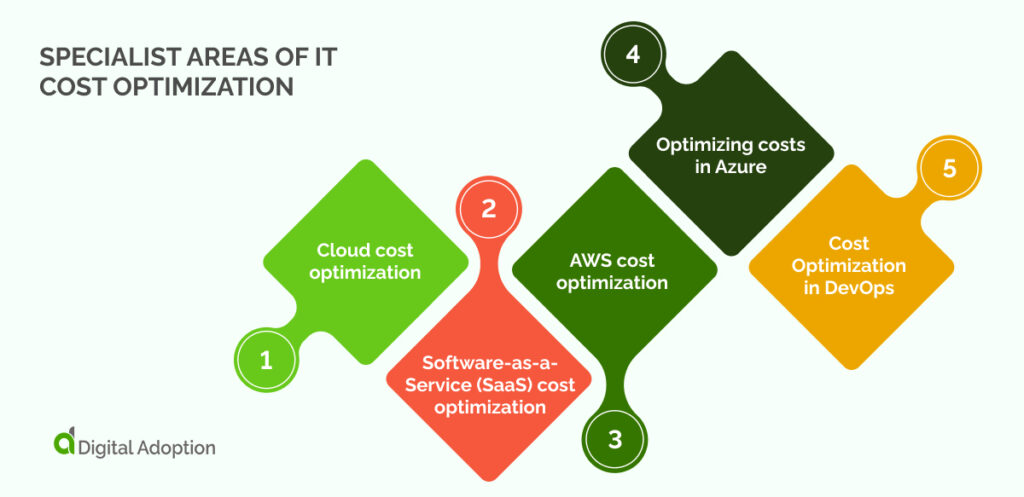
You’ve now got a broad idea of the main techniques for IT cost optimization. Yet many people will come to this article with more specific challenges. In this section, we’ll investigate some of the key niches of cost optimization: for cloud usage, SaaS packages, AWS, Azure, and DevOps.
Cloud cost optimization
Efficiently managing cloud costs is essential in modern IT. Planning, monitoring, evaluating, and revising cloud spending is crucial.
Cloud cost optimization is a specialist discipline in itself. Fortunately, new tools like McKinsey’s cloud cost simulator can help businesses identify and implement cost-saving opportunities within their cloud infrastructure.
Software-as-a-Service (SaaS) cost optimization
Optimizing Software-as-a-Service (SaaS) costs involves rationalizing subscriptions, rightsizing licenses, and aligning usage with actual needs. Continuous monitoring and adjusting SaaS expenses are key to achieving cost savings while maintaining productivity.
AWS cost optimization
For organizations using Amazon Web Services (AWS), cost optimization is achieved by understanding resource usage, leveraging reserved instances, and utilizing AWS Cost Explorer. Regular reviews of AWS spending are essential for cost efficiency.
Optimizing costs in Azure
In Microsoft Azure, cost optimization focuses on analyzing resource utilization, leveraging reserved instances, and employing Azure Cost Management tools. Proactive management of Azure services can lead to significant cost reductions.
Cost Optimization in DevOps
DevOps processes can benefit from cost optimization by streamlining development and operations, minimizing waste, and using automation to reduce manual tasks. It’s essential to align DevOps practices with cost-efficient resource utilization and ongoing improvements.
Get Your IT Cost Optimization Strategy Right
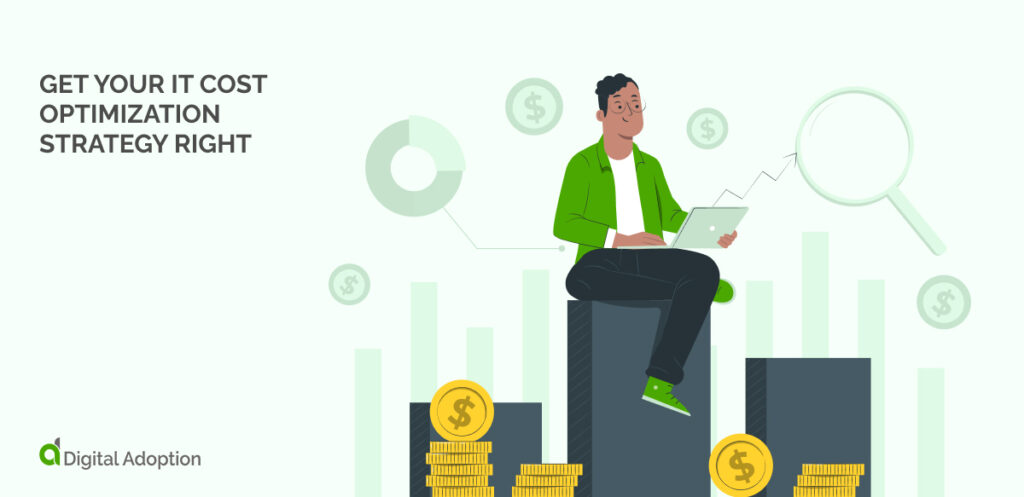
Why should you use strong cost optimization strategies? It’s simple—cost optimization of IT resources makes good business sense.
Even in these times of budget constraints and cuts, cost optimization initiatives have the potential to give enormous benefits to every company.
Spending and cost reduction do, however, also involve risks. Short-term thinking about IT resources could stifle innovation, reduce efficiency, and impact staff productivity and morale. You may need to include a risk assessment in your strategic process. But most importantly, don’t fiddle thoughtlessly with your organization’s business technology processes.
Investing more in IT when you were hoping to spend less may feel daunting, but companies worldwide have realized that an improved ROI is well within their grasp when they use a Digital Adoption Platform.

